Il était une fois...
Ted Forstmann, qui autrefois dans les années 80 s'était attaqué à la vogue des "junk bonds" et des raids boursiers, s'attaque aujourd'hui à la crise du crédit.
Et il a cette histoire enfantine à raconter :
"Once upon a time, when credit conditions and the costs of borrowing money were normal, the bank opened at 9:00 a.m. and closed at 5:00 p.m. For eight hours a day, bankers made loans and took deposits, and then they went home.C'est une bonne façon de résumer la crise actuelle il me semble...But after 9/11, the Fed opened the spigot. Short-term interest rates went to zero in real terms and then into negative territory. When real interest rates are negative, borrowing money is effectively free – the debt loses value faster than the interest adds up. This led to a series of distortions in the financial sector that are only now coming to light. The children's story continues: "Now they [the banks] have all this excess money. And they open at nine, and from nine to noon or so, they're doing all the same kind of basically legitimate things with it that they did before."
So far, so good. "But at noon, they have tons of money left. They have all this supply, and the, what I would call 'legitimate' demand – it's probably not a good word – but where risk and reward are still in balance, has been satisfied. But they're still open until five. And around 3:30 in the afternoon they get to such things as subprime mortgages, OK? And what you guys haven't seen yet is what happened between noon and 3:30."
Nous allons donc maintenant découvrir les effets de l'activité des banques entre midi et 15h30, et ensuite seulement, nous en aurons peut-être fini avec cette crise.
Autant dire que nous en sommes encore loin.
Cette anecdote est tirée d'un article très complet du Wall Street Journal
En résumé : "La crise du crédit va devenir pire encore" (ce n'est que le titre)
